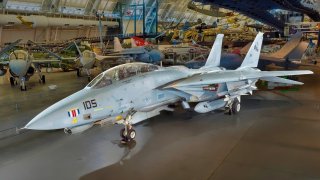The F-14 Tomcat Fighter Could Have Become a 'Bomber'
The F-14 Tomcat, a renowned U.S. Navy fighter linked to Top Gun, was originally designed to defend carrier groups against Soviet bombers. After the Cold War, the high maintenance cost and lack of a direct adversary led to its early retirement.
Summary and Key Points You Need to Know: The F-14 Tomcat, a renowned U.S. Navy fighter linked to Top Gun, was originally designed to defend carrier groups against Soviet bombers.
-After the Cold War, the high maintenance cost and lack of a direct adversary led to its early retirement.
-However, in the 1990s, the F-14B "Bombcat" emerged as a modified version, equipped with advanced avionics and the LANTIRN system, enabling precision-guided munitions delivery.
-Despite its enhanced capabilities, the Bombcat’s service life was short, with its final missions taking place in Yugoslavia and the Middle East before retirement in 2006.
From Fighter to Bomber: The F-14’s Last Transformation as the "Bombcat"
The U.S. military’s climb to air superiority can be attributed to the introduction of three fighter platforms in the 1970’s. When the F-14 Tomcat, the F-15 Eagle and the F-16 Fighting Falcon took to the skies, America’s aerial arsenal truly became unbeatable.
Currently, two of these airframes remain in service and production, while the Tomcat has been relegated to museums.
The fighter that is notoriously linked to the classic hit Top Gun is widely recognized for its role in protecting U.S. carrier groups from enemy fighters and platforms during its tenure in service.
However, the latest F-14 iteration has capabilities that were not as popularized in the mainstream. In the last years of its service life, the F-15 became a bomber, dubbed as the “Bombcat.”
An overview of the Tomcat
The F-14 platform can be linked back to the late 1950’s, when the U.S. Navy first sought a long-range, high-endurance interceptor to aid its mission set out at sea and beyond. Specifically, the service desired a platform that could defend carrier groups against Soviet bombers and sea-based vessels. Ultimately, the Tomcat emerged as a product of then-Secretary of Defense Robert McNamara’s Tactical Fighter Experimental Program, which was developed to create a cost-effective “joint” solution for the military. The Tomcat sported several advancements over its predecessors, including variable geometry wing set and the ability to carry long-range AWG-9 radar in addition to super-long-range AIM-54 Phoenix missiles.
While the Tomcat was a very powerful airframe at the time, following the dissolution of the Soviet Union the U.S. could not justify the jet’s maintenance on financial grounds. As explained by Popular Mechanics, without the presence of a “high-tech” adversarial air force there just wasn’t really an urgent need for the Tomcat in the immediate post-Cold War era.

According to some estimates, the F-14 required between 30 and 60 hours of maintenance for every one hour it spent in the air. This factor alone really fueled the argument for the Tomcat’s earlier retirement.
Introducing the F-14B “Bombcat”
However, since the F-14s still possessed many service hours left in the early 1990’s, the Navy decided to repurpose the airframes. The new and improved Tomcats were equipped with the LANTIRN system.
As detailed by the Aviationist, “The pod introduced a masking avoidance curve display, preventing the pilots to put the airframe between the pod and the target and interrupting the lasing, and a 12,200 m (40,000 ft) capable laser that became very useful later in the higher terrain of Afghanistan, allowing the Bombcat to employ guided munitions high above potential threats. Another capability was the generation of accurate coordinates for any target, located on the FLIR, that could be then passed to other aircraft or ground assets.”
The F-15B airframes also featured advanced engines, digital cockpit and better avionics.
Even equipped with these improvements, the Bombcat’s life in service was short-lived.
The U.S. Navy retired the F-14B iteration along with other Tomcat variants in 2006, but the Bombcat did perform in missions against Yugoslavia and the Middle East before being relegated to museum duty.
About the Author: Maya Carlin, Defense Expert
Maya Carlin is an analyst with the Center for Security Policy and a former Anna Sobol Levy Fellow at IDC Herzliya in Israel. She has by-lines in many publications, including The National Interest, Jerusalem Post, and Times of Israel. You can follow her on Twitter: @MayaCarlin.
Images: Creative Commons/U.S. Military.


